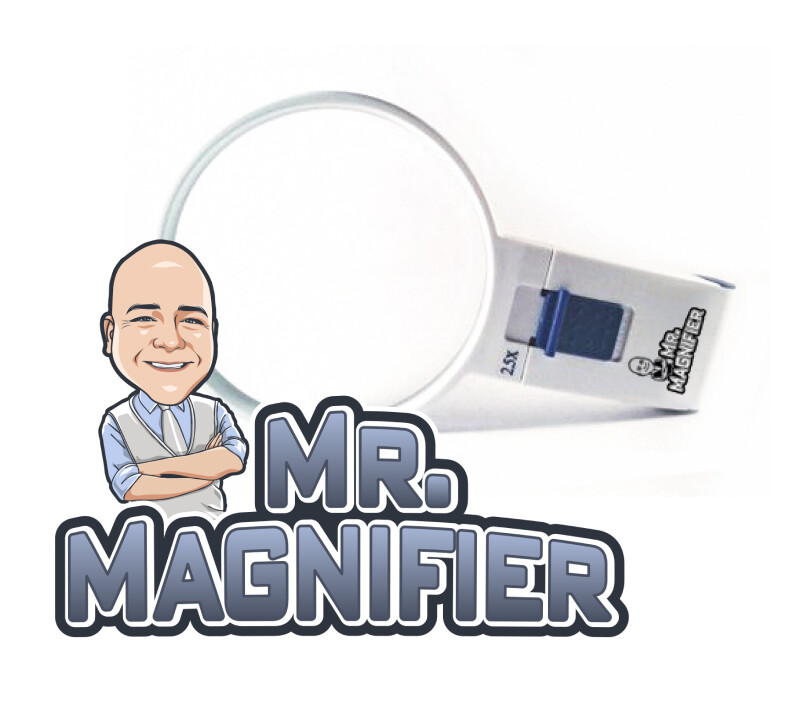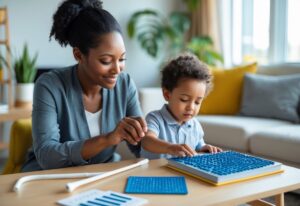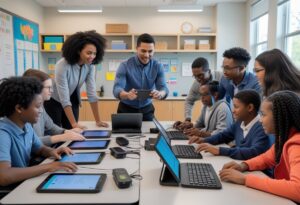Top Household Tools for Low Vision Users to Simplify Daily Living and Boost Independence

Essential Vision Assistance Tools for Daily Living
Choosing the right vision assistance tools makes it easier to manage daily household activities, read instructions, and stay organized. The right solutions improve safety and independence for people with low vision or visual impairment.
Low Vision Devices for Home Tasks
Low vision devices make daily living more practical for those with visual impairment. Electronic video magnifiers allow us to zoom in on printed materials, food labels, and bills, displaying crisp, high-contrast text on easy-to-see screens. Many models are portable, so moving from room to room is simple.
Wearable devices are another leading-edge option. Head-mounted displays or smart glasses can magnify text, recognize faces, and identify common household objects. Table-top CCTV systems, with adjustable contrast and brightness, help with reading, paying bills, and organizing recipes without strain.
Barcode scanner apps on smartphones can identify groceries, medications, and other household products. Combined with screen readers or voice output, these apps add convenience and help us maintain independence at home. For a wider view of available tools, see a list of low vision assistive devices.
Magnifying Glasses and Stand Magnifiers
Magnifying glasses are classic tools for those living with low vision. They come in different strengths and handle types for specialized tasks, like reading medication labels or checking oven dials. For hands-free options, stand magnifiers keep the lens steady above the page, making it easier to read, write, or sew. Some models include built-in LED lights for greater clarity and reduced eye strain.
We recommend using illuminated magnifiers for small print or detailed work. With a wide selection of sizes and light features, these tools help us accomplish daily tasks comfortably, even as lighting or print size changes. To explore more, review options for magnifying glasses and stand magnifiers.
Tactile Markers and Labeling Solutions
Tactile markers and labeling solutions help with quick identification around the house. Bump dots, raised tactile stickers, and textured tape are affordable ways to label appliances, light switches, and kitchen cabinets. These simple tools enable us to recognize commonly used buttons and dials by touch, reducing mistakes.
Braille labels and talking label kits are indispensable for people who are totally blind or have very limited vision. Custom tags can be attached to clothing, canned goods, or medicine bottles for easy organization. This labeling system minimizes confusion and helps us maintain a safe and organized living environment.
Lighting Enhancements for Improved Visibility
Adequate lighting helps reduce frustration and increases safety. Bright, adjustable, and flicker-free LED task lamps are widely used. They offer focused illumination for specific areas like reading nooks, kitchen counters, or bedside tables.
Anti-glare floor and table lamps improve overall room visibility and decrease shadows that make tasks more difficult. We suggest positioning lighting to avoid direct glare while increasing overall brightness. For activities like cooking or crafts, flexible units with movable necks are recommended. More details about improving daily activities with lighting can be found in this guide on low vision aids and lighting.
Smart Home Technology for Accessibility
Leading-edge smart home technology is transforming daily living for people with low vision. With voice activation, screen readers, and large-print interfaces, it is easier than ever to control household devices and manage routine tasks independently.
Voice-Controlled Smart Home Devices
Voice assistants like Amazon Alexa and Google Assistant provide hands-free control over lights, thermostats, and security systems. Users can operate smart plugs, door locks, and appliances with simple voice commands, minimizing the need to find and press physical buttons.
Many devices, such as the Echo Show, offer features designed for the blind and low vision community. The Show and Tell function, for example, helps users identify pantry items by announcing what’s held in front of the camera. This aids in safe, efficient meal preparation and daily organization.
People with limited vision or dexterity benefit from devices with tactile buttons and audible feedback, making everyday actions straightforward. For more information, our article details how voice assistants and smart controls enhance accessibility.
Smartphones and Tablets for Low Vision
Modern smartphones and tablets like the iPad have become vital tools for accessibility. Built-in magnification, large text settings, and voice control features help users read messages, browse the web, and use apps without strain.
Apple’s VoiceOver screen reader and Android’s TalkBack offer audio descriptions and spoken feedback, guiding users through menus and content. High-contrast display modes, text-to-speech, and zoom functions support reading, navigation, and app use in all lighting conditions.
Many daily living apps, such as color identifiers, barcode scanners, and medication reminders, are designed for users with limited vision. A smartphone or tablet is not just a communication device; it’s an adaptable, multi-use piece of assistive technology.
Electronic Devices with Built-In Accessibility
Televisions, home appliances, and other household electronics increasingly incorporate accessibility features. Modern TVs have audio description settings and screen readers, allowing users to navigate channels and menus independently.
Microwaves, ovens, and washing machines with tactile controls and voice prompts simplify food preparation and laundry tasks. Device manufacturers now prioritize universal design, so accessibility options are built-in rather than added on later.
Smart home hubs centralize control of these accessible devices, letting users manage multiple products through a single interface. By investing in electronic devices with robust accessibility settings, people with low vision can handle more household tasks safely and with greater confidence. For strategies to upgrade your home, see this guide on making your home accessible with technology enhancements.
Organizing and Managing Daily Tasks
Daily routines are easier to manage with tailored organizing tools, accessible kitchen equipment, and effective communication aids. These tools encourage greater independence and control, reducing frustration and streamlining daily life.
Labeling and Organizational Aids
Simple but effective labeling methods can make a significant difference for people with low vision. Using tactile markers, such as rubber bands, raised dots, or braille labels, helps differentiate common items in the pantry or bathroom. Items like bump dots can mark stove settings, remote controls, or detergents.
We also suggest color-contrasted labels for frequently used containers and mail. Paper clips attached in specific positions can organize bills or medication packets. Keeping shelves and drawers tidy, using organizer trays, and sorting items by shape and texture further minimize confusion at home. For more ideas, see how organization can eliminate common frustrations as outlined by the Wisconsin Department of Health Services.
Adaptive Kitchen and Household Tools
Preparing meals or maintaining the home often requires hands-on solutions. Talking appliances, like microwave ovens and kitchen scales, provide voice cues for safer, more accurate use. Cutting boards with high-contrast surfaces and measuring cups with tactile markings can simplify cooking tasks.
We recommend labeling items with tactile or large-print markers for greater ease. Organizing utensils by function using small bins or drawer dividers adds efficiency. Automatic can openers, easy-grip utensils, and liquid level indicators can also support daily independence. A list of recommended kitchen tools for visually impaired users is available for further reference.
Simple Communication Tools
Communication remains central to connection and independence. Large print or braille note cards allow us to make shopping lists and reminders for daily activities. Using tactile indicators, such as textured stickers for phone buttons, streamlines reaching out for help or staying in touch with loved ones.
We also find voice-activated devices—from telephones to smart assistants—helpful for sending messages or reminders hands-free. When labeling folders and mail, using bold markers with thick ink or large font labels increases visibility. Custom tactile systems for bills, mail, and calendars contribute to better organization and reduce stress related to managing personal affairs, as explored by the ConnectCenter on daily living skills.
Safety and Mobility at Home: Top Household Tools for Low Vision Users
For people with low vision or blindness, practical tools and home adaptations can make daily life safer and more manageable. Addressing household mobility challenges and reducing common hazards are essential for living confidently and independently.
Mobility Aids for Indoor Navigation
Moving safely around the house starts with reliable mobility aids. For many individuals, a white cane is essential for detecting changes in floor surfaces, obstacles, and the layout of rooms. Canes come in several varieties, including folding, straight, and support canes, which cater to different mobility needs.
Walkers with tactile grips or high-contrast markings can help those with both mobility and vision challenges. Specially designed tactile pathways or contrasting floor strips guide us through hallways and rooms. Handrails near stairs and ramps add an extra level of confidence.
Low vision users should also consider lightweight, high-contrast doorframes. These visual cues can be very helpful for navigation, especially in low-light conditions.
Safety Solutions to Prevent Accidents
Simple home modifications play a major role in fall and accident prevention. Securing carpets and rugs with non-slip pads helps to eliminate tripping hazards. Keeping pathways clear and decluttered is just as important for safe movement.
Bright, glare-free lighting minimizes shadows and illuminates floor surfaces. Installing automatic night lights in key areas such as hallways, bathrooms, and kitchens further improves safety. Labeling appliances and using tactile or audible devices for tasks like setting the oven or thermostat reduce risks while cooking or cleaning.
Adaptive products like talking timers and audible kitchen tools ensure key information is not missed due to low vision. Large print signage on doors and cabinets can reinforce organization and orientation around the home.
Enhancing Home Environment for Blindness
Adapting the home environment goes beyond mobility by making everyday spaces more intuitive. Tactile markers or raised dots on light switches, thermostats, and remote controls help us quickly locate essential controls, supporting both safety and comfort.
High-contrast color schemes are crucial in helping visually impaired users distinguish between walls, floors, and furniture. Bold, non-glare tape or paint on the edges of stairs or countertops offers clear visual cues. Organization is also vital—grouping related items together in labeled, easy-to-reach containers minimizes confusion and increases efficiency.
Accessible household items, such as tactile or talking clocks and independent living products with large print or audio support, help keep daily routines simple and stress-free. Taking these steps fosters an environment where we can move and function with greater ease and security.
Assistive Technology for Visual Impairment
Leading-edge assistive technology empowers those with visual impairment to navigate daily living, work, and leisure more independently. With advancements in digital tools and devices, household routines can become more manageable and efficient for people with low vision.
Screen Readers and Audio Assistance
Screen readers transform on-screen text to speech or braille, providing crucial access to information. Popular options include VoiceOver for Apple devices and TalkBack on Android systems, both of which allow users to perform most smartphone tasks with spoken feedback. These tools help users read emails, browse the web, and even shop online with ease.
Apps like “Audible” deliver access to an extensive library of audiobooks, making reading accessible regardless of print ability. Innovations in screen-reading software increasingly offer customizable voices and navigation, letting users tailor the experience to their preferences.
In many homes, screen readers are paired with voice assistants such as Amazon Alexa or Google Assistant for quick access to information, reminders, and managing household devices. These technologies support greater independence and efficiency.
Popular Apps for Low Vision Users
Apps play a vital role in day-to-day accessibility. “Be My Eyes” connects users with sighted volunteers for real-time visual assistance via video, perfect for identifying products or reading labels at home. Aira is another service, pairing users with professional agents who provide detailed visual descriptions, including navigation support outside and inside the home.
Navigation is further enhanced by tools like BlindSquare, which uses GPS to help users find locations and orient themselves in both new and familiar areas. Many low vision users depend on these apps to safely travel and manage complex environments.
To streamline routine tasks, several apps provide object recognition, color identification, and currency detection. These apps reduce reliance on others and help users perform responsibilities efficiently.
Assistive Technology Devices for Home
Physical assistive technology devices remain essential in the home environment. Electronic magnifiers, accessible thermostats, and voice-controlled appliances transform how visually impaired individuals manage daily tasks. Bump dots and tactile markers offer simple but effective labeling solutions for appliances, remote controls, and cooking items.
Audio labelers, which allow users to record and play back spoken labels, are highly effective for organizing household items and medication. Refreshable braille displays convert on-screen content into braille, making computers and smart devices accessible for braille readers.
For a comprehensive overview, see this A to Z list of assistive technology for low vision and explore how these technologies adapt to different needs. With thoughtful integration of such tools, a safer and more independent lifestyle is within reach.
Professional Resources and Support for Top Household Tools for Low Vision Users
Navigating vision loss can be eased with access to expert support and the right professionals. Comprehensive care and training empower individuals to use household tools confidently, with assistance tailored to specific needs such as macular degeneration or low vision.
Low Vision Centers and Occupational Therapists
Low vision centers serve as a crucial resource. These centers offer clinical assessments, device recommendations, and practical strategies for maximizing remaining vision in daily life. Through thorough evaluations, staff help us identify the specific challenges unique to our home environment.
Occupational therapists play a vital role in this process. They work directly with us to modify daily routines, teach adaptive techniques, and introduce appropriate household tools. Whether it’s instruction on using task lighting, labeling systems, or tactile markers, we benefit from their professional guidance.
Their support extends to helping us integrate new tools such as talking clocks, magnifiers, and accessible kitchen items. This support is important when adapting to progressive conditions like macular degeneration, ensuring we are safe and self-sufficient at home.
Rehabilitation and Training Services
Rehabilitation programs offer essential skills for those adjusting to vision loss. These services often include individual and group instruction on daily living activities, mobility, and the use of assistive devices.
Training covers tasks like meal preparation, personal care, and money management. Rehabilitation specialists break down each activity and adapt tools such as bump dots, large-print labels, and talking kitchen appliances. Rehabilitation and training services help individuals master tools for reading, writing, and home safety.
Many centers also provide counseling and peer support, recognizing the emotional aspects of vision loss. By learning practical skills and connecting with others, we feel more confident and less isolated when managing our daily routines.
Assistive Technology Specialists
Assistive technology specialists guide us in selecting and customizing devices that streamline daily tasks. These professionals assess our individual needs and recommend leading-edge solutions—ranging from smart home products to screen readers and accessible apps.
Instruction may include setting up voice-activated assistants, using magnification or text-to-speech features on devices, and exploring apps designed for navigation, reading, or organization. A variety of assistive technology and apps are available to enhance independence for people with low vision.
Our experts stay informed on advances in technology, ensuring that the solutions we adopt fit our lifestyle and needs. Ongoing support, troubleshooting, and custom training are part of their continuing service, making sure each tool remains effective in the long term.
Frequently Asked Questions
Practical tools can make everyday activities more manageable for those living with low vision. With the right assistive devices, technology, and organization strategies, it’s possible to live safely and independently at home.
What kinds of assistive devices are essential for cooking for someone with low vision?
Large print and tactile kitchen tools, talking timers, and audible measuring cups help make meal prep safer. Non-slip mats, high-contrast cutting boards, and bump dots for appliance controls are also useful.
Consider using gooseneck lamps or bright under-cabinet lights to clearly illuminate cooking spaces. We often recommend low vision assistive devices designed for improved safety in the kitchen.
How can visually impaired individuals identify medications more easily?
Medication organizers with large print or Braille labels work well. Some talking medication dispensers announce medications aloud, helping prevent errors.
Brightly colored tape or tactile stickers on bottles can also make identification easier. Pairing these tools with proper medication management routines reduces the risk of taking the wrong medicine.
What technology helps low vision users in reading text on various surfaces?
Electronic video magnifiers, digital readers, and text-to-speech devices are effective for reading mail, books, labels, and more. These devices can magnify or read aloud text from a variety of surfaces.
Wearable devices and smart glasses are another option, letting users hear or see enlarged text in real-time. Many find that these low vision aids transform how they interact with printed materials.
Can you recommend organizational tools to help those with low vision manage their household?
Color-coded bins, tactile labels, and large-print calendars help visually impaired users manage tasks and belongings. Drawer dividers with bold markings can also make organizing easier.
Talking clocks and electronic pill organizers provide auditory reminders throughout the day. Simple adaptations, like using Velcro dots or rubber bands, create tactile markers for important household items.
What are some adaptive solutions for low vision users to perform personal grooming?
Talking bathroom scales, magnifying mirrors with lights, and shaver guides all help increase independence in grooming. Bump dots on hairdryer or electric razor controls make it simpler to adjust settings.
For applying makeup, illuminated magnification mirrors and makeup guides with raised edges can help ensure accuracy. Good lighting in the bathroom is essential.
Which mobile apps are designed to assist low vision users with daily tasks?
There are apps that read printed text aloud, identify objects, and scan barcodes for product info. Apps like Be My Eyes and Aira connect users with sighted assistance through video calls.
Home assistants such as Google Home and Amazon Alexa support hands-free control of reminders, timers, and smart devices. Many of these solutions are discussed in this well-regarded resource chosen by experienced users in the blind and visually impaired community.
How Can We Help
TechCare
Regain confidence and simplify your daily routines with our TechCare Senior Technology Training at New England Low Vision and Blindness. Whether it’s learning to navigate your smartphone, set up video calls with loved ones, or manage online appointments, our experts provide personalized, one-on-one support tailored to the unique needs of older adults. From iPhones to Alexa and everything in between, we make technology accessible, approachable, and stress-free.
With our TechCare service, we help you learn, set up, troubleshoot, and feel confident using the technology that matters most to you! Contact us today for a free consultation. Visit https://nelowvision.com/retirement-community-ideas/ to learn more.
Smart Home
Enhance your independence and safety with our Smart Home Service at New England Low Vision and Blindness. From voice-activated lighting to accessible home automation systems, we specialize in customizing your living environment to meet the needs of individuals with low vision. Discover how our experts can help you create a smarter, more functional home by visiting our Smart Homes page https://nelowvision.com/smart-homes/
With our Smart Home service, we help you learn, purchase, set up, and train the right option for you!






